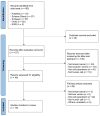Systematic Review of the Antitumor Activities and Mechanisms of Scorpion Venom on Human Breast Cancer Cells Lines (In Vitro Study)
- PMID: 40364211
- PMCID: PMC12072316
- DOI: 10.3390/jcm14093181
Systematic Review of the Antitumor Activities and Mechanisms of Scorpion Venom on Human Breast Cancer Cells Lines (In Vitro Study)
Abstract
Background/Objectives: Breast cancer remains the most prevalent malignancy among women worldwide. Innovative therapies are essential to address its diverse subtypes and treatment resistance. Scorpion venom and its bioactive proteins have gained attention as potential anticancer agents owing to their multitargeted cellular effects. This review systematically evaluates their anticancer properties and mechanisms in breast cancer, highlighting therapeutic potential. Methods: A systematic search was conducted in five databases (PubMed, Science Direct, EMBASE, OVID, and KISS) up to September 2024. Only in vitro studies using breast cancer cell lines and investigating scorpion venom or its bioactive proteins were included. Extracted data covered study characteristics, intervention types, control groups, dose range, duration, and key outcomes. Results: In total, 19 studies met the eligibility criteria. Crude scorpion venom showed broad cytotoxicity against hormone receptor-positive, triple-negative, and HER2-positive breast cancer subtypes. The primary mechanisms included apoptosis induction, DNA fragmentation, oxidative stress modulation, and cell cycle regulation. Bioactive proteins, such as chlorotoxin (CTX) and Neopladine 1/2, exhibited selective anticancer effects by targeting signaling pathways, inhibiting migration and invasion, and promoting apoptosis. Conclusion: These findings support scorpion venom's potential as a multitargeted anticancer agent. The complementary actions of crude venom and its proteins highlight their promise for combination therapies. Further research is needed to clarify their synergistic interactions and optimize preclinical and clinical applications.
Keywords: anticancer activity; apoptosis; breast cancer; scorpion venom.
Conflict of interest statement
The authors declare no conflicts of interest. The funders had no role in the design of the study; in the collection, analyses, or interpretation of data; in the writing of the manuscript; or in the decision to publish the results.
Similar articles
-
Scorpion Venom Causes Apoptosis by Increasing Reactive Oxygen Species and Cell Cycle Arrest in MDA-MB-231 and HCT-8 Cancer Cell Lines.J Evid Based Integr Med. 2018 Jan-Dec;23:2156587217751796. doi: 10.1177/2156587217751796. J Evid Based Integr Med. 2018. PMID: 29405760 Free PMC article.
-
Anticancer potentiality of Hottentotta saulcyi scorpion curd venom against breast cancer: an in vitro and in vivo study.Sci Rep. 2024 Oct 19;14(1):24607. doi: 10.1038/s41598-024-75183-w. Sci Rep. 2024. PMID: 39427017 Free PMC article.
-
Scorpion Venom Causes Upregulation of p53 and Downregulation of Bcl-xL and BID Protein Expression by Modulating Signaling Proteins Erk1/2 and STAT3, and DNA Damage in Breast and Colorectal Cancer Cell Lines.Integr Cancer Ther. 2018 Jun;17(2):271-281. doi: 10.1177/1534735417704949. Epub 2017 Apr 25. Integr Cancer Ther. 2018. PMID: 28438053 Free PMC article.
-
Anticancer Activity of Bee Venom Components against Breast Cancer.Toxins (Basel). 2022 Jul 5;14(7):460. doi: 10.3390/toxins14070460. Toxins (Basel). 2022. PMID: 35878198 Free PMC article. Review.
-
Pleiotropic Anticancer Properties of Scorpion Venom Peptides: Rhopalurus princeps Venom as an Anticancer Agent.Drug Des Devel Ther. 2020 Feb 27;14:881-893. doi: 10.2147/DDDT.S231008. eCollection 2020. Drug Des Devel Ther. 2020. PMID: 32161447 Free PMC article. Review.
References
-
- Eccles S.A., Aboagye E.O., Ali S., Anderson A.S., Armes J., Berditchevski F., Blaydes J.P., Brennan K., Brown N.J., Bryant H.E., et al. Critical research gaps and translational priorities for the successful prevention and treatment of breast cancer. Breast Cancer Res. 2013;15:R92. doi: 10.1186/bcr3493. - DOI - PMC - PubMed
-
- Arnold M., Karim-Kos H.E., Coebergh J.W., Byrnes G., Antilla A., Ferlay J., Renehan A.G., Forman D., Soerjomataram I. Recent trends in incidence of five common cancers in 26 European countries since 1988: Analysis of the European Cancer Observatory. Eur. J. Cancer. 2015;51:1164–1187. doi: 10.1016/j.ejca.2013.09.002. - DOI - PubMed
Publication types
Grants and funding
LinkOut - more resources
Full Text Sources
Research Materials
Miscellaneous


